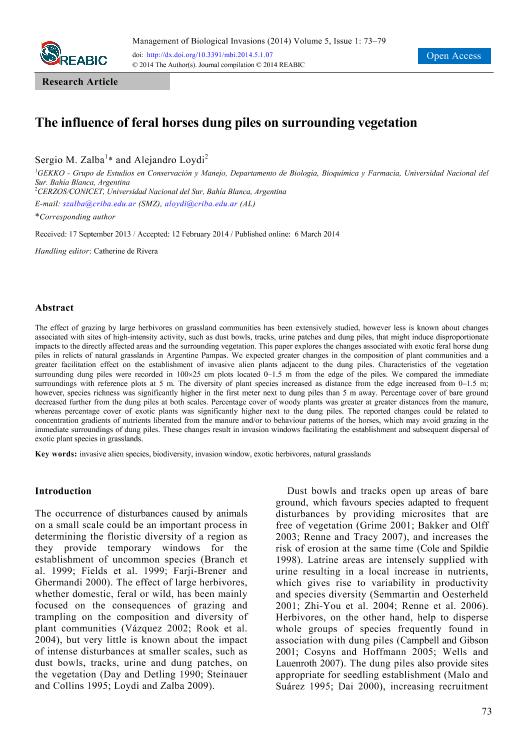Mostrar el registro sencillo del ítem
dc.contributor.author
Zalba, Sergio Martin

dc.contributor.author
Loydi, Alejandro

dc.date.available
2017-01-16T19:46:27Z
dc.date.issued
2014-05
dc.identifier.citation
Zalba, Sergio Martin; Loydi, Alejandro; The influence of feral horses dung piles on surrounding vegetation; Regional Euro-Asian Biological Invasions Centre; Management of Biological Invasions; 5; 1; 5-2014; 73-79
dc.identifier.issn
1989-8649
dc.identifier.uri
http://hdl.handle.net/11336/11418
dc.description.abstract
The effect of grazing by large herbivores on grassland communities has been extensively studied, however less is known about changes associated with sites of high-intensity activity, such as dust bowls, tracks, urine patches and dung piles, that might induce disproportionate impacts to the directly affected areas and the surrounding vegetation. This paper explores the changes associated with exotic feral horse dung piles in relicts of natural grasslands in Argentine Pampas. We expected greater changes in the composition of plant communities and a greater facilitation effect on the establishment of invasive alien plants adjacent to the dung piles. Characteristics of the vegetation surrounding dung piles were recorded in 10025 cm plots located 0–1.5 m from the edge of the piles. We compared the immediate surroundings with reference plots at 5 m. The diversity of plant species increased as distance from the edge increased from 0–1.5 m; however, species richness was significantly higher in the first meter next to dung piles than 5 m away. Percentage cover of bare ground decreased further from the dung piles at both scales. Percentage cover of woody plants was greater at greater distances from the manure, whereas percentage cover of exotic plants was significantly higher next to the dung piles. The reported changes could be related to concentration gradients of nutrients liberated from the manure and/or to behaviour patterns of the horses, which may avoid grazing in the immediate surroundings of dung piles. These changes result in invasion windows facilitating the establishment and subsequent dispersal of exotic plant species in grasslands.
dc.format
application/pdf
dc.language.iso
eng
dc.publisher
Regional Euro-Asian Biological Invasions Centre
dc.rights
info:eu-repo/semantics/openAccess
dc.rights.uri
https://creativecommons.org/licenses/by-nc-sa/2.5/ar/
dc.subject
Invasive Alien Species
dc.subject
Biodiversity
dc.subject
Invasion Window
dc.subject
Exotic Herbivores
dc.subject
Natural Grasslands
dc.subject.classification
Ecología

dc.subject.classification
Ciencias Biológicas

dc.subject.classification
CIENCIAS NATURALES Y EXACTAS

dc.subject.classification
Agricultura

dc.subject.classification
Agricultura, Silvicultura y Pesca

dc.subject.classification
CIENCIAS AGRÍCOLAS

dc.title
The influence of feral horses dung piles on surrounding vegetation
dc.type
info:eu-repo/semantics/article
dc.type
info:ar-repo/semantics/artículo
dc.type
info:eu-repo/semantics/publishedVersion
dc.date.updated
2017-01-13T20:05:33Z
dc.journal.volume
5
dc.journal.number
1
dc.journal.pagination
73-79
dc.journal.pais
Finlandia

dc.journal.ciudad
Helsinki
dc.description.fil
Fil: Zalba, Sergio Martin. Universidad Nacional del Sur. Departamento de Biologia, Bioquimica y Farmacia. Grupo de Estudios En Conservacion y Manejo; Argentina. Consejo Nacional de Investigaciones Científicas y Técnicas; Argentina
dc.description.fil
Fil: Loydi, Alejandro. Consejo Nacional de Investigaciones Científicas y Técnicas. Centro Científico Tecnológico Bahía Blanca. Centro de Recursos Naturales Renovables de la Zona Semiárida(i); Argentina
dc.journal.title
Management of Biological Invasions
dc.relation.alternativeid
info:eu-repo/semantics/altIdentifier/url/http://www.reabic.net/journals/mbi/2014/1/MBI_2014_Zalba_Loydi.pdf
dc.relation.alternativeid
info:eu-repo/semantics/altIdentifier/doi/http://dx.doi.org/10.3391/mbi.2014.5.1.07
Archivos asociados
